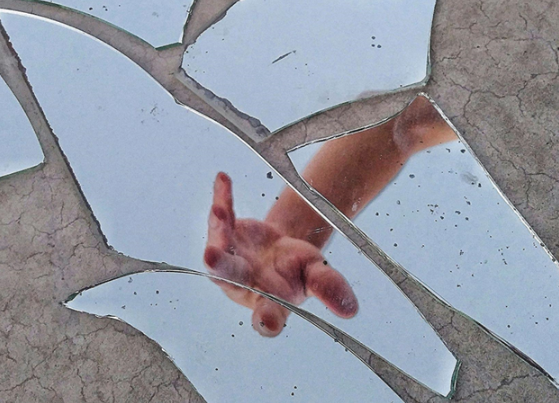Beyond the Mirror: Reshaping Body Image Among Youth

In a world where beauty standards often confine us to mirrors, it is time to shatter the glass and re-write the story of body image - one where authenticity, diversity, autonomy, and acceptance fill the pages for youth. As society increasingly turns to various forms of media to inform how they view themselves, their bodies, and the bodies around them, the importance of challenging these narratives within the educational environment becomes increasingly paramount.
How can this be done? It’s not merely about changing how youth see themselves in the mirror, but rather, about shifting the very foundations upon which their perceptions are built. Schools can emerge as catalysts for transformation, empowering young minds to embrace their inherent worth and celebrate the beauty of diversity if they begin to examine and challenge the very systems and perspectives that current body narratives are built upon. Physical and Health Education (PHE) classes are a perfect space to lead the way in supporting the wellness and well-being of youth when it comes to shifting the perceptions and perspectives around body image. Within this article, we take you through a journey of professional development by exploring and opening a dialogue around various racial and colonial implications of body and food narratives, how this can impact one’s view on body image, and a variety of ways that PHE teachers can begin re-writing body and food narratives with students in a tangible, and actionable way.

Racial and Colonial Implications of Body and Food Narratives
To challenge and re-write body stories, we first need to be aware of and recognize the systems we are working against. Whether you’ve experienced or have engaged in the following types of implications, we want to remind teachers to have self-compassion for themselves and to not feel shame or guilt over trying to do what they thought was best.
Have you ever noticed yourself complimenting others for weight loss? Praising students for eating their fruits and vegetables over the granola bar in their lunch kit? Perhaps talking with your colleagues about what diets they are on, while sitting around the lunch table? If yes, you may not have been aware that these are representations of weight bias, ableism, classism, and even racism. Yes. Racism. In her book ‘Fearing the Black Body: The Racial Origins of Fat Phobia’, Sabrina Strings weaves together a historical narrative that demonstrates how attitudes towards fatness did not stem from medical discoveries, but rather, emerged from the Enlightenment period's notion that fatness symbolized "savagery" and racial inferiority depicted by black folks. This was particularly evident during the transatlantic slave trade, during which time white Europeans sought new ways to differentiate themselves from those of black slaves. Europeans were portrayed as slender individuals who had rational “self-control”, while reversely, black folks were depicted as unable to control themselves, equating curves and fleshiness with blackness and savagery.
In regard to the forms of ableism and classism mentioned earlier: Imagine existing in a body that experienced a condition disabling you from consuming certain foods that are deemed “good”, while needing to rely on foods deemed “bad” to survive. This is true for many folks suffering from chronic illness (ie. Chron’s disease, Diabetes), food sensitivities, allergies, and other health conditions. Folks struggling with these conditions may be left to feel as though their bodies are “bad” or insufficient if they experience barriers to eating “good” foods. The same is true for families who experience financial barriers to accessing certain foods.
To add an additional layer, even the formula we have used to determine when and how much we should eat is rooted in colonial and racist practices. When colonizers came to North America, they viewed the traditional grazing practices of Indigenous people as indicative of “savagery”. Colonizers viewed “civilized people” as capable of setting boundaries with themselves and with food, which led to the imposition of a three meal a day system that was used to “domesticate” Indigenous communities (Carroll, 2013).
If we want students to feel good about their bodies, we need to change the way we look at and speak about food and bodies. However, this is just the beginning. We also need to begin unpacking, evaluating, challenging, and divesting from the very systems our current perspectives are rooted in.
As you move through your journey, you may notice some discomfort and resistance. Common points of resistance that are witnessed, particularly in the school environment, surround misconceptions around health and wellness. There are often concerns expressed in regard to promoting “unhealthy” eating practices, feeling uneasy about not following the Canada Food Guide, and the desire to protect children from being subjects of weight prejudice. The following is offered to begin re-evaluating these concerns:
- If you have ever been on a diet, tried to restrict your food intake or been very conscious about the foods you eat to be “healthy”, I imagine you have lived experience with how stressful and perhaps even dehumanizing it feels to reduce your self-worth down to the food you are putting in your body. We ask you to consider - what is healthy about this? The stress and shame that is often induced when requiring someone to monitor their body is certainly more harmful than providing children the opportunity to listen to their bodies, eat what feels best for them, and trust that their bodies know best.
- Encouraging children to befriend their bodies and trust their intuition, rather than expecting them to follow culturally biased norms and expectations, is associated with a variety of positive outcomes. Intuitive eating, at its roots, is an approach to eating that relies on internal cues and needs, rather than restrained eating that requires rigid control and adherence to food-based rules (ie. number of calories, types of foods). A meta-analysis of intuitive eating showed that individuals who engage in intuitive eating are less likely to experience binge eating, emotional eating, or dietary restriction. Intuitive eating was also associated with increased awareness of internal body cues, a greater appreciation for one’s body, and an increased tendency to reject cultural appearance ideals (Linardon, Tylka, & Fuller‐Tyszkiewicz, 2021).
- If your hopes are to protect children from weight prejudice and fatphobia, the answer is to resist the systems (ie. racism, white supremacy, colonialism, capitalism) that perpetuate these perspectives, rather than expecting children to change their bodies to conform to rules embedded within these belief systems. If we continue to tell children they need to lose weight, watch what they are eating, or control their bodies to feel better about themselves, we are setting them up for a losing battle. Research indicates that (95% of) diets result in regaining weight, and about one to two thirds of people end up heavier than they were before they began (Mann et al., 2007; Siahpush et al., 2015). If you were to try and control a child’s body shape or size, the likelihood is that your attempts will fail, and the child will be left to feel the resulting shame surrounding their body and eating practices.
You might be wondering - this is great and all, but what does this look like in practice? Below are a variety of ways to begin re-writing body and food narratives with students in your Physical and Health Education classes in a tangible, and actionable way.
(1) Well-being Focused
- Focus on aspects of students’ identity outside of their appearance. Encourage exploration and discussion surrounding what makes each student who they are. This should include recognition and celebration of intersectional identities (ie. ethnicity, culture, religion, gender, sexuality, etc).
- Be mindful of representation; images and resources provided to students should include a variety of cultures, gender identities, and body sizes (ie. anatomy textbooks, posters around the school, cafeteria food selections)
(2) Food Focused
- Avoid labeling foods as healthy and unhealthy/good and bad. Instead, explore the different ways food can meet different needs. For example, some foods give us more energy, some are nutrient dense, others connect us to our culture, some foods bring us happiness, and others meet spiritual or religious needs.
- Avoid praising individuals for eating specific foods and specific food amounts. Ensure there are no expectations to eat certain foods (i.e., only fruits or vegetables at snack time). This provides the message that certain foods are “better” than others, and these foods may not be accessible to all students.
- Avoid commenting on your own or students’ bodies, even if it is a “compliment”. This provides the message that certain bodies or looks are more desirable than others.
- Get curious with students about the ways they have been exposed to diet culture and weight bias. This can be supported by critically examining social media posts, magazines, commercials, etc. We cannot dismantle these systems all at once, but we can certainly increase media literacy to support students in recognizing and challenging these messages. Ask your students the following questions:
(i) What about this content demonstrates diet culture?
(ii) What message is this piece of content sending about food/values/self-worth?
(iii) How do you feel about yourself when you view this post?
(iv) How would you re-create the original diet culture post you found through the lens of body neutrality or a HAES principle? If this isn’t possible (perhaps the original post is too oppressive to change), get creative!
(3) School Focused
- Encourage students to listen to their bodies and eat when their bodies are giving them cues - Look to build positive, trusting relationships with their bodies! Remember, scheduling times for food consumption is rooted in colonial and racist values. If a child is hungry, they should be given the opportunity to eat.
- Although the Canada Food Guide can be used as a curriculum resource, use it as a starting point for discussions. Move to critically examining the guide and how it does not take into account food security, cultural dishes, religious practices, or personalized needs (i.e., allergies, health conditions).
- Embrace a Comprehensive School Health (CSH) Framework that focuses on how well-being is an essential component of student achievement and success. Schools can do this by creating positive school environments, such as providing a variety of physical environments and classroom spaces, encourage informal instruction (ie., talking with students at recess), and including students in discussions around school and division policies.
- Find ways to incorporate joyful movement and encourage students to provide feedback surrounding more structured forms of movement. Not all students will like all sports/physical activities and that’s OKAY! You can use this feedback as an opportunity to discuss intuition and embodiment.
- Be flexible with clothing options for PE. Like adults, children and adolescents also have a variety of clothing they may feel most comfortable in when they move their bodies. What is regulated/expected, might not feel safe or comfortable for some students. In addition, teachers formatively and summatively assess students based on outcomes listed in the curriculum. As long as students can meet the outcomes in a safe manner, it should not matter what clothing they are wearing!
- Not every student will be a top athlete, so it is important to include a variety of games, activities, and movement breaks that are inclusive and equitable. For example, when playing an activity, in PE class, break it down into smaller chunks that allow for students of all levels to work on what you are assessing. This can encourage students to trust their own body and understand what their body can do. Taking a step back, and understanding the small practices our body supports, is important to strengthen the relationship we have with bodies.
References
Carroll, A. (2013). Three squares the invention of the American meal. Basic Books, a member of the Perseus Books Group.
Ever Active Schools (2023). Comprehensive School Health. https://everactive.org/comprehensive-school-health/
Linardon, J., Tylka, T. L., & Fuller‐Tyszkiewicz, M. (2021). Intuitive eating and its psychological correlates: A meta‐analysis. International Journal of Eating Disorders, 54(7), 1073-1098.
Mann, T., Tomiyama, A. J., Westling, E., Lew, A. M., Samuels, B., & Chatman, J. (2007). Medicare's search for effective obesity treatments: diets are not the answer. American Psychologist, 62(3), 220.
Siahpush, M., Tibbits, M., Shaikh, R. A., Singh, G. K., Sikora Kessler, A., & Huang, T. T. K. (2015). Dieting increases the likelihood of subsequent obesity and BMI gain: results from a prospective study of an Australian national sample. International Journal of Behavioral Medicine, 22, 662-671.
Strings, S. (2020). Fearing the black body: The racial origins of fat phobia.









